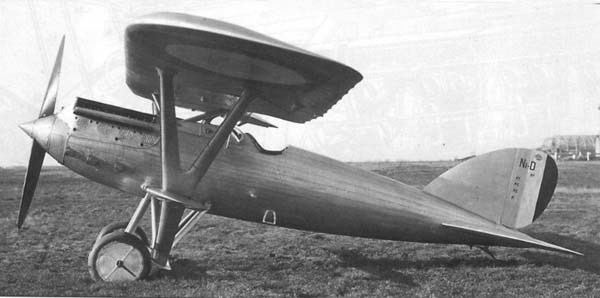Wingspan 12 m Length 7.5 m Retired 1940 Designer Gustave Delage | Top speed 265 km/h Introduced 1924 Manufacturer Nieuport | |
 | ||
The Nieuport-Delage NiD 42 was a fighter aircraft built in France in the early 1920s, the first in a family of designs that would form the backbone of the French fighter force over the next decade.
Contents
Design and development
As first built, the NiD 42 was a highly streamlined parasol-wing monoplane with a monocoque fuselage and an open cockpit of which a single prototype was built. Soon afterwards, Nieuport-Delage built two examples of a modified version for the 1924 Coupe Beaumont as the NiD 42S, on which the main wings were mounted directly to the sides of the upper fuselage at shoulder position with a short subsidiary wing fitted around the undercarriage axle.. To further streamline the design, the surface radiators were installed on the upper surface of the wing.
Operational history
One of these aircraft was flown by Joseph Sadi Lecointe in the race of 22 June and was the only one out of the five entrants to actually finish the course. Indeed, having finished the prescribed six laps of the 50 km (31 mi) course, Sadi-Lecointe flew another four laps to break the world speed record over a 500-km closed-course. His average speed in winning the Coupe Beaumont was 311 km/h (193 mph; 168 kn) and over the 500 km (310 mi) was 306 km/h (190 mph; 165 kn), beating the previous record for the latter by 36 km/h (22 mph; 19 kn). On 15 February the following year, Sadi Lecointe took a NiD 42S up to a speed of 375 km/h (233 mph; 202 kn) and went on to win the 1925 Coupe Beaumont with a NiD 42S on 18 October with an average speed of 313 km/h (194 mph; 169 kn).
While the NiD 42S was achieving these distinctions, development continued on the fighter version. Nieuport-Delage designed two further such variants in 1924; a single-seater designated NiD 42 C.1 and a similar machine with a second cockpit for a tail gunner with a machine gun in a ring mount, designated the NiD 42 C.2. One of the latter was exhibited at that year's Salon de l'Aéronautique, along with a NiD 42 C.1 nose section to illustrate an alternative engine mount. These differed from the original NiD 42 fighter in having a second, small wing added to the lower fuselage, turning the parasol monoplane into a sesquiplane, a design feature adopted from the NiD 37 which would be a key identifying feature through most of the versions developed from the 42.
Only two examples of the two-seater were built, but Nieuport-Delage entered the single-seater in the 1925 concours des monoplaces, a competition by the Army's Technical Service to find a replacement for the NiD 29. The NiD 42 was selected from a field of eleven competitors, and an order for 50 aircraft was placed, of which 25 were eventually delivered. Although impressive at the time it was designed, technology had already surpassed the NiD 42 when it entered service in 1928, particularly with regard to its wooden structure, and most of the development work associated with the design was made in an effort to cure it of a tendency to enter a flat spin. Nevertheless, it provided the foundation for further development as the NiD 52 and NiD 62.
Variants
Operators
Specifications (NiD 42 C1)
Data from "Nieuport-Delage NiD-42"
General characteristics
Performance
Armament
